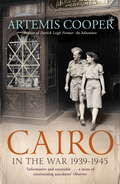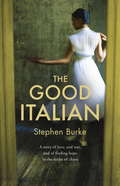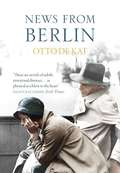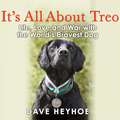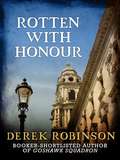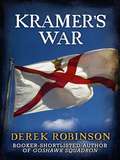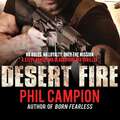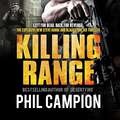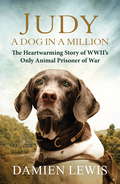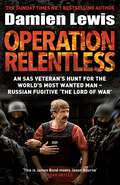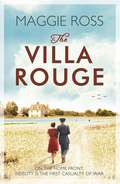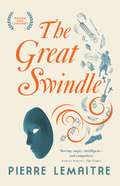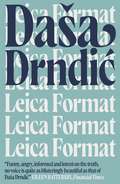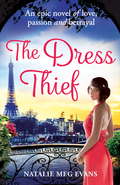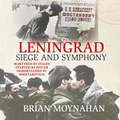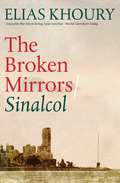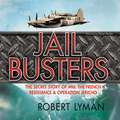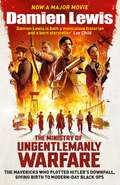- Table View
- List View
Cairo in the War: 1939-45
by Artemis CooperFor troops in the desert, Cairo meant fleshpots or brass hats. For well-connected officers, it meant polo at the Gezira Club and drinks at Shepheard's. For the irregular warriors, Cairo was a city to throw legendary parties before the next mission behind enemy lines. For countless refugees, it was a stopping place in the long struggle home. The political scene was dominated by the British Ambassador Sir Miles Lampson. In February 1942 he surrounded the Abdin Palace with tanks and attempted to depose King Farouk. Five months later it looked as if the British would be thrown out of Egypt for good. Rommel's forces were only sixty miles from Alexandria - but the Germans were pushed back and Cairo life went on. Meanwhile, in the Egyptian Army, a handful of young officers were thinking dangerous thoughts.
Cairo in the War: 1939-45
by Artemis CooperFor troops in the desert, Cairo meant fleshpots or brass hats. For well-connected officers, it meant polo at the Gezira Club and drinks at Shepheard's. For the irregular warriors, Cairo was a city to throw legendary parties before the next mission behind enemy lines. For countless refugees, it was a stopping place in the long struggle home. The political scene was dominated by the British Ambassador Sir Miles Lampson. In February 1942 he surrounded the Abdin Palace with tanks and attempted to depose King Farouk. Five months later it looked as if the British would be thrown out of Egypt for good. Rommel's forces were only sixty miles from Alexandria - but the Germans were pushed back and Cairo life went on. Meanwhile, in the Egyptian Army, a handful of young officers were thinking dangerous thoughts.
The Good Italian
by Stephen BurkeEnzo Secchi, harbourmaster for Massawa, Eritrea's main port, is a loyal Italian colonial servant. He takes pride in running the docks, enjoys the occasional drink with his gregarious friend Salvatore, colonel of the local Italian garrison, and listens to Caruso in his spare time. But he is lonely and when Salvatore suggests he find an Eritrean housekeeper to cook, clean - and maybe share his bed - Enzo takes the plunge and advertises. Salvatore's own tastes run to the young and nubile, but Enzo surprises himself by choosing Aatifa, a sharp-tongued woman in her 30s with a complicated family life, who takes the job as a last resort. What neither of them had counted on was falling in love.But it is 1935, Fascism is on the rise, and Mussolini does not intend Eritrea to remain a backwater for long. Italian forces bent on invading Ethiopia begin arriving at the port. And with them come new laws - including one forbidding 'Relationships of a Conjugal Nature' with Eritrean women . . .Meanwhile, Salvatore finds himself at the head of the invasion force bound for Ethiopia. Gone are the glory days of garrison life; it is a bitter campaign, laying bare all the brutality of Italian colonial ambition. Its consequences for Salvatore, and for Enzo and Aatifa as they contrive to hide their relationship in plain sight, will change all three lives for ever.
News from Berlin
by Otto de KatJune 1941. Dutch diplomat Oscar Verschuur has been posted to neutral Switzerland. His family is spread across Europe. His wife Kate works as a nurse in London and their daughter Emma is living in Berlin with her husband Carl, a 'good' German who works at the Ministry of Foreign Affairs. Briefly reunited with her father in a restaurant in Geneva, Emma drops a bombshell. A date and a codename, and the fate of nations is placed in Verschuur's hands: June 22, Barbarossa. What should he do? Warn the world, or put his daughter's safety first? The Gestapo are watching them both. And with Stalin lulled by his alliance with Hitler, will anyone even listen? Otto de Kat is fast gaining a reputation as one of Europe's sharpest and most lucid writers. News from Berlin, a book for all readers, a true page-turner driven by the pulse of a ticking clock, confirms him as a storyteller of subtly extravagant gifts.
It's All About Treo: Life and War with the World's Bravest Dog
by Damien Lewis Dave HeyhoeWhen Dave Heyhoe was sent to Afghanistan to help detect the Taliban's murderous roadside bombs, he knew he'd need a special dog by his side. Luckily for him, his closest pal Treo, a staggeringly brave ball of energy and mischief was with him every step of the way. The two friends had a miraculous understanding that helped them save countless lives but, as they embarked on a roller-coaster emotional ride, Dave realized he needed Treo more than he could ever have imagined. Tear-jerkingly sad one moment, laugh-out-loud hilarious the next, It's All About Treo is a moving and uplifting story that will melt the hearts of animal lovers everywhere. (P)2013 Quercus Publishing Plc / WF Howes
Rotten With Honour
by Derek RobinsonMikhail Starin, Head of Soviet Intelligence in London, is a ruthless, cold-hearted individual. Known to have killed 24 people, including his own mother, he's now determined to get his hands on a hard-to-stabilize nuclear formula. There's only one thing for British Intelligence to do: send him back to Russia as quickly as possible. They scheme to leak details of a top-level Western military secret - knowing that when the Russians discover the secret is a double cross, Starin is history. Unfortunately there's only one man available to oversee the job: David Hale; young, honourable, but completely out of his depth. Rotten with Honour is a Cold War espionage thriller told with the trademark wit of Derek Robinson, bestselling and Booker-shortlisted author of Goshawk Squadron.
Kramer's War
by Derek RobinsonJersey, 1944. Lieutenant Earl Kramer, sole survivor of a ditched USAF bomber, crawls out of the sea one night and cuts the throat of a German sentry. Big mistake. Jersey is under Nazi occupation, and the lives of its inhabitants depend on an uneasy co-existence with their oppressors. Though Kramer's motives were entirely patriotic, to the islanders he presents a terrifying risk to their very survival. But to Kramer, a man governed by an overriding sense of duty, this stronghold of Hitler's armies proves too irresistible a target to ignore... Kramer's War is a powerful novel about the savagery of war, from the bestselling and Booker-shortlisted author of Goshawk Squadron.
Kramer's War
by Derek RobinsonJersey, 1944. Lieutenant Earl Kramer, sole survivor of a ditched USAF bomber, crawls out of the sea one night and cuts the throat of a German sentry. Big mistake. Jersey is under Nazi occupation, and the lives of its inhabitants depend on an uneasy co-existence with their oppressors. Though Kramer's motives were entirely patriotic, to the islanders he presents a terrifying risk to their very survival. But to Kramer, a man governed by an overriding sense of duty, this stronghold of Hitler's armies proves too irresistible a target to ignore... Kramer's War is a powerful novel about the savagery of war, from the bestselling and Booker-shortlisted author of Goshawk Squadron.
Desert Fire
by Phil CampionSultan Gadaffi has escaped from Libya with a fistful of dangerous secrets. The British Government want ex-Special Forces operative Steve Range, the go-to man for any Black-Ops missions, to lead an ultra-covert mercenary group to seize him from his near-impregnable desert stronghold. Saed is defended by Tuareg warriors armed to the teeth with stolen NATO hardware. If Range's team can somehow overcome them, then they will earn themselves gold bullion worth $500 million. But as the bullets begin to fly and the body count rises, Range realises that he's been double-crossed. Unwilling to lose the gold, he begins to contemplate cutting a deal with the devil.(P)2013 WF Howes Ltd
Killing Range: Left for Dead. Back for Revenge.
by Phil CampionSteve Range believes his friend Randy is a corpse in a desert grave - until he reappears in an Al Qaeda video, spitting extremist hate and challenging Range and Blackstone Six to a desert battle that will settle a vicious blood feud. But Range's attention is drawn to a clue slipped in to Randy's tirade, and he begins to wonder whether his old comrade-in-arms really has been turned by his captors. All he knows for sure is that he owes a debt to the man he left for dead. Range leads a team from Blackstone Six on a high-stakes rescue mission, but he soon finds that his elite band of operators are facing a desperate fight like no other, one in which old loyalties and friendships will be tested to the limit and beyond.(P)2013 WF Howest Ltd
Judy: From Runaway Puppy to the World's Most Heroic Dog
by Damien LewisThe impossibly moving story of how Judy, World War Two's only animal POW, brought hope in the midst of hell.Judy, a beautiful liver and white English pointer, and the only animal POW of WWII, truly was a dog in a million, cherished and adored by the British, Australian, American and other Allied servicemen who fought to survive alongside her. Viewed largely as human by those who shared her extraordinary life, Judy's uncanny ability to sense danger, matched with her quick-thinking and impossible daring saved countless lives. She was a close companion to men who became like a family to her, sharing in both the tragedies and joys they faced. It was in recognition of the extraordinary friendship and protection she offered amidst the unforgiving and savage environment of a Japanese prison camp in Indonesia that she gained her formal status as a POW. Judy's unique combination of courage, kindness and fun repaid that honour a thousand times over and her incredible story is one of the most heartwarming and inspiring tales you will ever read.
Judy: From Runaway Puppy to the World's Most Heroic Dog
by Damien LewisThe impossibly moving story of how Judy, World War Two's only animal POW, brought hope in the midst of hell.Judy, a beautiful liver and white English pointer, and the only animal POW of WWII, truly was a dog in a million, cherished and adored by the British, Australian, American and other Allied servicemen who fought to survive alongside her. Viewed largely as human by those who shared her extraordinary life, Judy's uncanny ability to sense danger, matched with her quick-thinking and impossible daring saved countless lives. She was a close companion to men who became like a family to her, sharing in both the tragedies and joys they faced. It was in recognition of the extraordinary friendship and protection she offered amidst the unforgiving and savage environment of a Japanese prison camp in Indonesia that she gained her formal status as a POW. Judy's unique combination of courage, kindness and fun repaid that honour a thousand times over and her incredible story is one of the most heartwarming and inspiring tales you will ever read.
Operation Relentless: The Hunt for the Richest, Deadliest Criminal in History
by Damien Lewis'The Night Manager meets Narcos' Saul David'To catch this criminal took incredible courage and skill. This is James Bond meets Jason Bourne' Bear GryllsThe new bestseller from the author of Zero Six BravoBy 2007 Viktor Bout had become the world's foremost arms dealer. Known as the 'Merchant of Death' he was both "Public Enemy No. 1" to the global intelligence agencies and a ruthless criminal worth around six billion dollars.For years Bout had eluded capture, meanwhile building up a labyrinthine network of airlines selling weapons to order to dictators, rebels, despots and terror groups worldwide. He was hunted by the CIA, NSA, MI6, as well sought by the United Nations for being their top global sanctions buster. Holed up in Moscow - from where he ran a suite of offices selling anything from AK47s to state-of-the-art helicopter gunships and anti-aircraft missiles - he was shielded by a Russian state that was a partner in his dark dealings. In short, Bout appeared utterly invulnerable and beyond any hope of capture. Step forward former SAS man Mike Snow. After serving in the Regiment, Snow had worked as a bush pilot in Africa, where he'd got to know Bout well. Via its own secretive, shadow network, Snow was approached by the US DEA, the Drugs Enforcement Agency. The DEA agents had one question for him: was Snow able to get to Viktor Bout? This is the incredible tale of OPERATION RELENTLESS, the top-secret mission that Snow and a handful of DEA operatives launched to entrap Viktor Bout - a story that ranges from the steamy jungles of Colombia to the ice-bound streets of Moscow, and from horrific bloodshed and tyranny in the Congo, to a snatch operation like no other. It may read like an implausible thriller, but every word of Operation Relentless is true.
Operation Relentless: The Hunt for the Richest, Deadliest Criminal in History
by Damien LewisFor years Bout had eluded capture, meanwhile building up a labyrinthine network of airlines selling weapons to order to dictators, rebels, despots and terror groups worldwide. He was hunted by the CIA, NSA, MI6, as well sought by the United Nations for being their top global sanctions buster. Holed up in Moscow - from where he ran a suite of offices selling anything from AK47s to state-of-the-art helicopter gunships and anti-aircraft missiles - he was shielded by a Russian state that was a partner in his dark dealings. In short, Bout appeared utterly invulnerable and beyond any hope of capture. Step forward former SAS man Mike Snow. After serving in the Regiment, Snow had worked as a bush pilot in Africa, where he'd got to know Bout well. Via its own secretive, shadow network, Snow was approached by the US DEA, the Drugs Enforcement Agency. The DEA agents had one question for him: was Snow able to get to Viktor Bout? This is the incredible tale of OPERATION RELENTLESS, the top-secret mission that Snow and a handful of DEA operatives launched to entrap Viktor Bout - a story that ranges from the steamy jungles of Colombia to the ice-bound streets of Moscow, and from horrific bloodshed and tyranny in the Congo, to a snatch operation like no other. It may read like an implausible thriller, but every word of Operation Relentless is true.
The Villa Rouge
by Maggie RossMorgan Perincall's marriage is already disintegrating when her husband volunteers for service in France. Dazed by his desertion, she sends their children west to safety, and leaves London for the dubious sanctuary of her childhood home, the Villa Rouge. Situated on the East coast, it is vulnerable to German attack. Caught between the open hostility of her father's housekeeper and the suffocating affection of Charlie, who for all his enthusiasm is not fit for service, Morgan's days are brightened by the arrival of an R.A.F. squadron - a chance to relive the romances of her wilder youth. But the fall of Dunkirk brings a sobering taste of defeat, and the Battle of Britain soon sees the once-carefree pilots fighting for their lives, their country. With danger drawing ever closer, and the secrets of her past beginning to unravel, Morgan discovers that sometimes the best intentions can leave the darkest legacies.
The Great Swindle: Prize-winning historical fiction by a master of suspense
by Pierre LemaitreNow a major French film Au revoir là-haut - Prix Goncourt-winning masterpiece by the writer who brought you Alex, Irène and Camille.October 1918: the war on the Western Front is all but over. Desperate for one last chance of promotion, the ambitious Lieutenant Henri d'Aulnay Pradelle sends two scouts over the top, and secretly shoots them in the back to incite his men to heroic action once more.And so is set in motion a series of devastating events that will inextricably bind together the fates and fortunes of Pradelle and the two soldiers who witness his crime: Albert Maillard and Édouard Péricourt.Back in civilian life, Albert and Édouard struggle to adjust to a society whose reverence for its dead cannot quite match its resentment for those who survived. But the two soldiers conspire to enact an audacious form of revenge against the country that abandoned them to penury and despair, with a scheme to swindle the whole of France on an epic scale.Meanwhile, believing her brother killed in action, Édouard's sister Madeleine has married Pradelle, who is running a little scam of his own...
The Great Swindle: Prize-winning historical fiction by a master of suspense
by Pierre LemaitreNow a major French film Au revoir là-haut - Prix Goncourt-winning masterpiece by the writer who brought you Alex, Irène and Camille.October 1918: the war on the Western Front is all but over. Desperate for one last chance of promotion, the ambitious Lieutenant Henri d'Aulnay Pradelle sends two scouts over the top, and secretly shoots them in the back to incite his men to heroic action once more.And so is set in motion a series of devastating events that will inextricably bind together the fates and fortunes of Pradelle and the two soldiers who witness his crime: Albert Maillard and Édouard Péricourt.Back in civilian life, Albert and Édouard struggle to adjust to a society whose reverence for its dead cannot quite match its resentment for those who survived. But the two soldiers conspire to enact an audacious form of revenge against the country that abandoned them to penury and despair, with a scheme to swindle the whole of France on an epic scale.Meanwhile, believing her brother killed in action, Édouard's sister Madeleine has married Pradelle, who is running a little scam of his own...
Leica Format
by Daša DrndicThis is like a fairy tale, all this. A woman meets a stranger who tells her her identity is a lie. 772 (or 789) children's brains rest silently in jars. A traveller comes to a quotidian city, unknowingly approaching her past. From the author of Trieste (shortlisted for the Independent Foreign Fiction Prize) comes this bedazzling kaleidoscopic novel, stitching together fact and fiction, history and memory, words and images into a heart-breaking collage that manages to look askance at the blinding horror of history. Ranging across themes of memory, loss, inheritance and storytelling, Drndic borrows from every tradition of writing to weave together a fragmented narrative of love and disease, in a novel that's very format raises penetrating and unanswerable questions about history, and the processes by which we describe and remember it.
The Dress Thief: one secret could destroy everything she holds dear...
by Natalie Meg EvansAlix Gower may be poor but she's also ambitious, and she'd do anything to secure her dream job in one of Paris's premier fashion houses. But Alix also has a secret: she supports her family by stealing from the very houses she so adores. But can Alix risk her reputation and her relationships forever? And is the handsome English reporter she keeps bumping into really to be trusted? 'Wonderful! I didn't want to put this book down' Amazon reviewer. Perfect for fans of The Keeper of Lost Things, Island of Secrets and Amy Snow.
Leningrad: Siege and Symphony
by Brian MoynahanIn Leningrad: Siege and Symphony, Brian Moynahan sets the composition of Shostakovich's most famous work against the tragic canvas of the siege itself and the years of repression and terror that preceded it.Drawing on extensive primary research in archives as well as personal letters and diaries, he vividly tells the story of the cruelties heaped by the twin monsters of the 20th century, Stalin and Hitler, on a city of exquisite beauty, and of its no less remarkable survival.Weaving Shostakovich's own story and that of many others into the context of the maelstrom of Stalin's purges and the Nazis' brutal invasion of Russia, Leningrad: Siege and Symphony is a magisterial and moving account of one of the most tragic periods of the twentieth century. (P)2013 WF Howes Ltd
The Broken Mirrors: Sinalcol
by Elias KhouryWhy did he return to Beirut? Why did Karim leave his wife and children and the life he had built in France to return to a homeland still reeling from civil war? Was it to answer his brother Nasim's call to raise a hospital out of the ashes? Was it to kick over the traces of past love affairs? Or to establish the truth behind his father's death? Or was it to confront at last the ghost of the man known only as "Sinalcol", a legendary phantom of the civil war, and a broken mirror of himself? In Beirut, Karim will learn the fate of old comrades, and face a brother who shares a past as divided as the city itself. And he will find that peace is only ever fleeting in a war without end.
Zero Six Bravo: 60 Special Forces. 100,000 Enemy. The Explosive True Story
by Damien LewisDamien Lewis has spent twenty years reporting from conflict zones around the world. Zero Six Bravo--a Sunday Times number one bestseller--tells the story of "sixty special forces against 100,000--a feat of arms to take the breath away." (Frederick Forsythe) They were branded as cowards and accused desertion. But nothing could be further from the truth. Ten years on, the story of these sixty men can finally be told. In March 2003, M Squadron--an SBS unit with SAS embeds--was sent 1,000 kilometers behind enemy lines on a true mission impossible, to take the surrender of the 100,000-strong Iraqi Army 5th Corps, an operation so risky it earned the nickname â??Operation No Return' right out of the gate. Caught in a ferocious ambush by Saddam Hussein's Fedayeen, plus the awesome firepower of the 5th Corps' heavy armor, and with eight of their vehicles bogged in Iraqi swamps, M Squadron launched a desperate bid to escape, inflicting massive damage on their enemies. Running low on fuel and ammunition, outnumbered, and outgunned, the elite operators destroyed sensitive information and prepared for death or capture as the Iraqis closed their deadly trap. Zero Six Bravo contains previously unpublished information detailing the essential involvement of American troops in this astonishing military feat. Zero Six Bravo recounts in vivid and compelling detail the most desperate battle fought by British and allied Special Forces trapped behind enemy lines since World War Two.(P)2014 WF Howes Ltd
The Jail Busters: The Secret Story of MI6, the French Resistance and Operation Jericho
by Robert LymanIn the new year of 1944 the French Resistance in northern France was on its knees. Relentless attacks on its diverse and disorganised networks by the Gestapo and the Abwehr had put many of its best operatives in prison, or worse. But in the lead up to Operation Overlord, 'D Day', the Resistance had never been more important to the Allied war effort, and many groups were in the pay of Britain's Secret Intelligence Service, MI6. One such was organised by a patriot called Dominic Ponchardier. For months he had watched helplessly as his friends and colleagues had been swept up by the Nazi drag net, and cast into the old prison on the eastern outskirts of Amiens. In desperation he asked his MI6 handlers for help, and once London agreed it led to one of the most daring missions of the war. On the morning of 18 February 1944, nineteen Mosquito bombers flew at low level across the channel, skimming just above the ground to drop their bombs on sections of the walls of Amiens Prison. Hundreds escaped, scores of whom evaded recapture to continue the fight against Nazi repression. It was an epic of precision bombing, in which one of the most notable RAF heroes of the war, Group Captain Charles Pickard, lost his life. Robert Lyman's book reveals, from previously unseen sources, the full truth of MI6's involvement in the French Resistance, and narrates in vivid detail a stirring tale of courage and skill.(P) 2014 WF Howes Ltd
Churchill's Secret Warriors: The Explosive True Story of the Special Forces Desperadoes of WWII
by Damien LewisOne of the most remarkable stories in the history of Special Forces' operations - Daily ExpressIn the bleak moments after defeat on mainland Europe in winter 1939, Winston Churchill knew that Britain had to strike back hard. So Britain's wartime leader called for the lightning development of a completely new kind of warfare, recruiting a band of eccentric free-thinking warriors to become the first 'deniable' secret operatives to strike behind enemy lines, offering these volunteers nothing but the potential for glory and all-but-certain death. Churchill's Secret Warriors tells the story of the daring victories for this small force of 'freelance pirates', undertaking devastatingly effective missions against the Nazis, often dressed in enemy uniforms and with enemy kit, breaking all previously held rules of warfare. Master storyteller Damien Lewis brings the adventures of the secret unit to life, weaving together the stories of the soldiers' brotherhood in this compelling narrative, from the unit's earliest missions to the death of their leader just weeks before the end of the war.
Churchill's Secret Warriors: The Explosive True Story of the Special Forces Desperadoes of WWII
by Damien LewisOne of the most remarkable stories in the history of Special Forces' operations - Daily ExpressIn the bleak moments after defeat on mainland Europe in winter 1939, Winston Churchill knew that Britain had to strike back hard. So Britain's wartime leader called for the lightning development of a completely new kind of warfare, recruiting a band of eccentric free-thinking warriors to become the first 'deniable' secret operatives to strike behind enemy lines, offering these volunteers nothing but the potential for glory and all-but-certain death. Churchill's Secret Warriors tells the story of the daring victories for this small force of 'freelance pirates', undertaking devastatingly effective missions against the Nazis, often dressed in enemy uniforms and with enemy kit, breaking all previously held rules of warfare. Master storyteller Damien Lewis brings the adventures of the secret unit to life, weaving together the stories of the soldiers' brotherhood in this compelling narrative, from the unit's earliest missions to the death of their leader just weeks before the end of the war.
